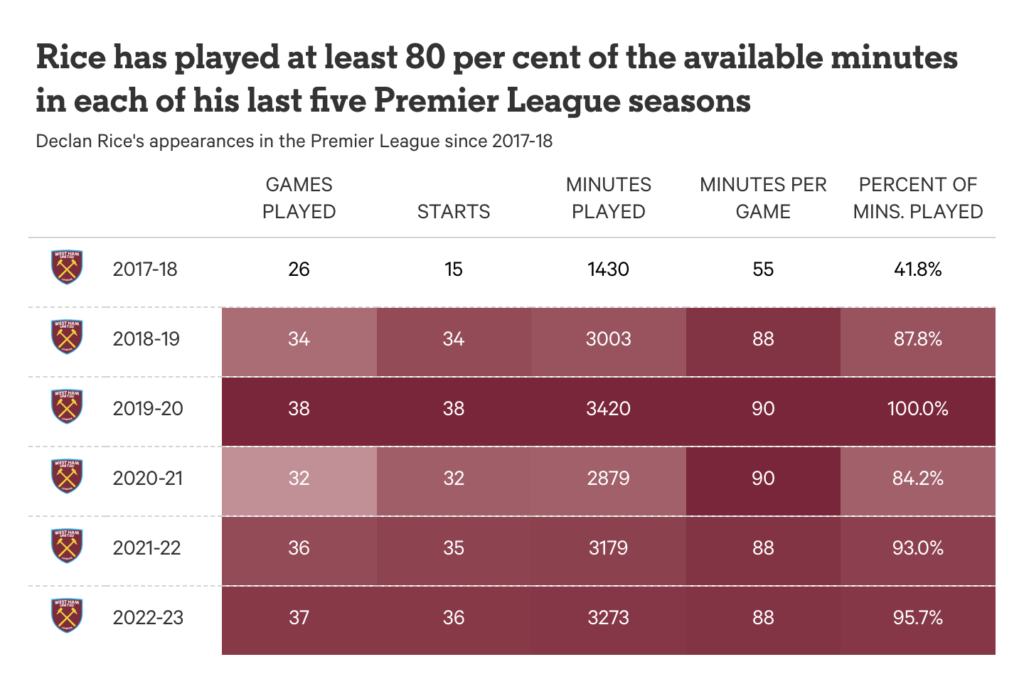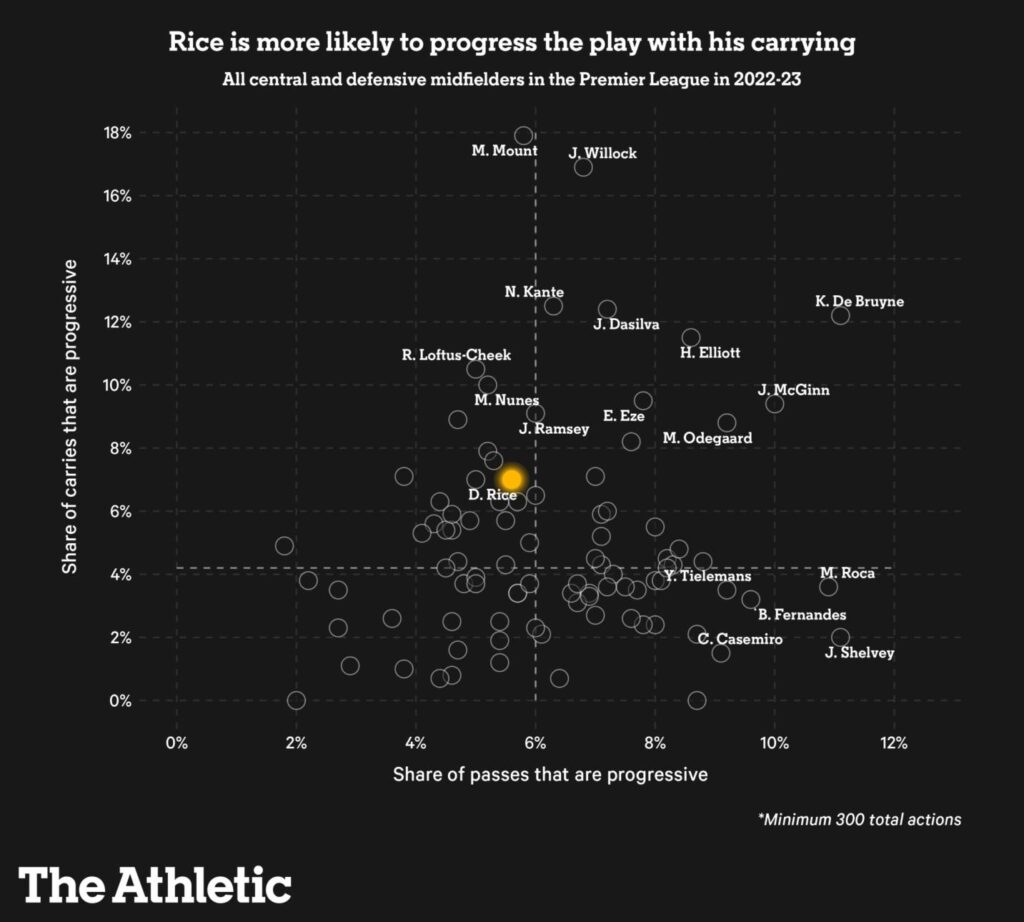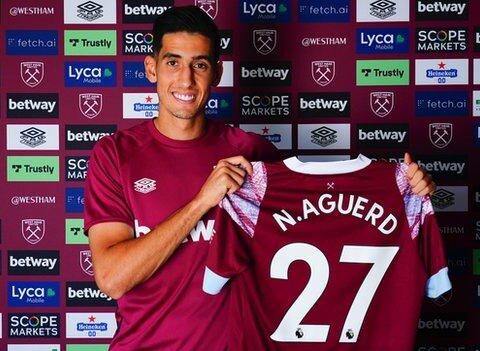Prior to examining Rice’s on-field conduct, it is important to consider how much football he has played in previous seasons. Following his promotion to the first team with West Ham in 2017–18, when he made 15 Premier League starts, Rice has logged at least 80% of the top-flight minutes in each of the last five seasons, including every minute of the 2019–20 season that was disrupted by Covid-19.
The fact that Rice played at least 3,000 league minutes in four of those seasons (falling just over one match short in the other) demonstrates his tenacity, which is all the more remarkable given his midfield position. Rice (15,753) is the only outfield player to have played more Premier League minutes since 2018–19 than James Tarkowski (16,274).

Rice’s primary strength from his midfield position is his ability to start with his characteristics out of possession, despite the fact that it may seem paradoxical.
It is not unexpected to observe that Rice does not rush into tackles at the first hint of danger because David Moyes’ West Ham side tends not to be front-foot aggressors out of possession. Instead, he keeps a close eye on the middle, maintains positional discipline, and only plays defence when it is necessary.
Declan Rice is naturally gifted and a versatile player-
This is evident in the statistics, where Rice ranks 62nd out of 69 defensive and central midfielders with 900+ Premier League minutes played last season with 4.2 “true” tackles, which are defined as tackles plus challenges lost plus fouls committed, per 1,000 opponent touches.
Importantly, Rice’s strategy assures that he will frequently come out on top when he does put a foot in. Nobody among the 69 players in the same pool has a greater “true” tackle victory rate than his 70%. Since his days at the academy, when he first demonstrated that he was as capable at playing center-back, Rice’s keen sense of the game has been refined.

When Rice is not participating in the challenge, he regularly steps forward to intercept errant passes and regain possession. Rice’s rate of 2.3 “true” interceptions, which includes interceptions and blocked passes, was the 10th highest among his 68 midfield peers last season. This is not to argue that he isn’t capable of acting more “front-foot.” Rice would probably be required to do more complex defensive manoeuvres if he were to join a top-four club this summer because elite teams are frequently characterised by an aggressive, high press.
The 6ft 1in (185cm) Rice, who possesses a large athletic build and the ability to flourish in a high-pressing system, has failed to consistently display these qualities for club or nation owing to the role he is required to play in both teams. He is seldom asked to go out to press high up the pitch by Moyes, and he serves as a single pivot for Gareth Southgate’s England as West Ham normally sit in a mid-to-low block when out of possession.
Now that his unquestionable defensive intelligence has been demonstrated, how does Rice perform when in possession?
Averaging 57.3 passes per 90 minutes in the Premier League last season, more than any West Ham player to see at least 900 minutes of playing action, he is quite simply the man responsible for making Moyes’ club tick.
With West Ham having the fewest passes per switch of play in the Premier League (90.4), it’s difficult to separate Rice’s particular style from the demands placed on him by his manager. This highlights how frequently they attempt to transfer the ball from side to flank.
Rice will undoubtedly be required to pass the ball to his teammates’ feet faster with smooth passes hit between the lines rather than cross-field diagonals in a better offensive side than West Ham.

However, especially facing deeper-block clubs that defend narrowly to condense space, Rice’s skill at switching play might be a beneficial tool for Arsenal. Bukayo Saka and Martinelli are particularly effective attacking one-on-one players on either flank, so elite teams like theirs frequently need to be patient when moving the ball from left to right in order to isolate their key forwards from their counterparts and shift the opponent’s defensive structure.
Similar to how Pep Guardiola’s treble-winning Manchester City team frequently uses the “exchange and switch” pattern, Rice’s passing range may fit in wonderfully with this tactic.
The stats says everything
Rice tops the list for the average distance of all advanced carries made by the same set of midfielders, coming in at 20.8 metres per carry, demonstrating his desire to extend out and sprint forward when given the chance.
When comparing Rice’s carrying to passing percentages, it becomes clear that he prefers to run with the ball, but not as frequently as certain Premier League players. While just 5% of his passes are progressive, which explains why he throws the ball less frequently to teammates who are ahead of him on the field, despite the fact that 7% of his total carries are progressive, ranking him above average among his contemporaries.

Should Rice put some effort into this? Perhaps, but unless his new manager asks him to adjust to a new role, it will be hard to separate his skill set from the demands of the team style.




